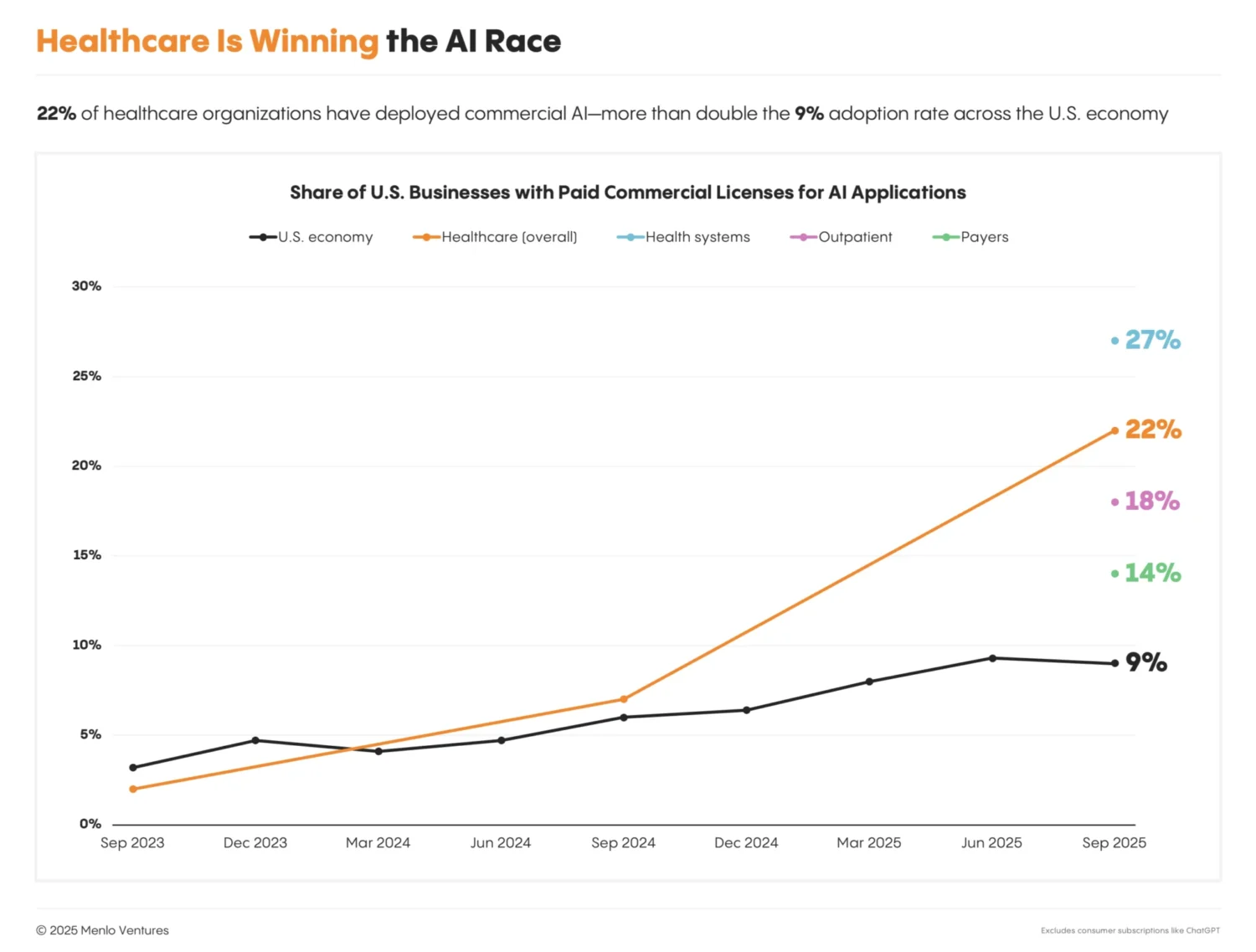
What You Should Know:
– According to the inaugural State of AI in Healthcare Report from Menlo Ventures, AI spending in the sector is surging, reaching $1.4 billion in 2025—nearly tripling last year’s total. Remarkably, healthcare organizations are now adopting AI solutions 2.2x faster than the broader economy, quickly shedding its reputation as a technology laggard.
– The report, based on a survey of over 700 healthcare executives, indicates that the industry is rapidly deploying specialized, domain-specific AI tools to tackle critical issues like administrative overhead, physician burnout, and R&D inefficiency. The evidence shows that for many organizations, the question is no longer if AI is valuable, but how fast it can be deployed to the production environment.
Key Findings: The Shift from Pilot to Production
The data confirms that healthcare is at an inflection point, with high-velocity adoption and spending concentrated in immediate ROI areas.
- Spending Explodes: Total AI spending in healthcare is up to $1.4 billion in 2025, marking almost a three-fold increase from the prior year. This rapid investment has been efficient, with the vast majority of the money flowing into production deployments, not just proof-of-concept pilots.
- Adoption Leadership: Healthcare has flipped the script, now adopting AI 2.2x faster than the broader economy. 22% of healthcare organizations have deployed domain-specific AI solutions, a massive 7x increase over 2024. Health systems are leading the charge at 27% adoption, outpacing outpatient providers (18%) and payers (14%).
- Unicorn Factory: The surge in activity has produced eight AI unicorns across key areas like medical documentation, RCM, and payer operations—more than any other vertical AI category.
Where the Dollars Are Flowing: Administrative Relief
The market’s biggest breakout categories are those that offer immediate relief to the financial and human costs of administrative work.
- Provider Dominance: Of the $1.4 billion flowing into the market, providers account for $1 billion (75%) of the spend, highlighting their urgent need to improve efficiency and combat staff shortages.
- The Big Two: Two categories dominate spending: ambient clinical documentation ($600 million), which targets physician burnout by automating note-taking, and coding and billing automation ($450M), which helps recover revenue lost to errors.
- Fastest-Growing Opportunities: AI is aggressively moving into other administrative service gaps. Patient engagement solutions are growing at +20x year-over-year, and AI for prior authorization is accelerating at +10x year-over-year. These categories, which involve automating workflows that were traditionally manual and staff-intensive, are turning services dollars into software dollars for the first time.
The Procurement Divide and Market Tensions
The pace of technology adoption differs significantly across the sector, and the rise of AI is creating friction between innovative startups and entrenched incumbents.
Providers Accelerate, Payers Deliberate
While providers are racing to capture operational benefits, payers are exercising greater caution. Health systems have dramatically shortened their buying cycles by 18%, and outpatient providers by 22%, as they move quickly to deploy production systems.
In contrast, payers have seen their buying cycles lengthen by 20%, indicating that they remain in a more cautious, deliberative, and experimentation phase. Payers’ primary concern is that provider AI tools, by optimizing billing and speeding up submissions, will lead to a surge in claims volume and potentially increase medical costs.
The Startup vs. Incumbent Showdown
Startups currently capture 85% of all generative AI spend in healthcare. They dominate with AI-native architecture in breakout fields like ambient scribing and chart review. However, the incumbents are fighting back fiercely. The market for ambient scribes—AI’s first breakout category—is facing a retention crisis, with 67% of outpatient providers expecting to switch vendors within three years, viewing the technology as increasingly commoditized.
The data reveals a critical tension: although startups are winning the revenue battle now, most customers still report a slight preference for buying AI from their incumbent EHR provider (Epic, Oracle Health, etc.) for crucial functions like coding, billing, and clinical decision support. The deep integration and trusted relationship of the incumbent remain a powerful, enduring advantage.
Life Sciences: Building Proprietary Defenses
The pharma and biotech sector is approaching AI with a different strategy, focused less on buying off-the-shelf software and more on building internal IP.
- Proprietary Models: 66% of pharma and biotech companies are prioritizing the effort to build or fine-tune proprietary models tailored for biology and drug discovery.
- R&D Focus: Their main area of interest is R&D data analysis (63%), leveraging AI to ingest public data, analyze experimental results, and accelerate the costly, time-consuming drug development lifecycle.
Healthcare Automation: The Most Significant Opportunity
The report concludes that the most significant opportunity lies ahead: automating the $740 billion in total annual U.S. administrative spending that was previously inaccessible to software. The next wave of innovation will be defined by companies that can solve the “product and workflow problems” of integrating these powerful AI tools into the messy, complex reality of patient care.
Click here to learn more about the State of AI in Healthcare Report.

